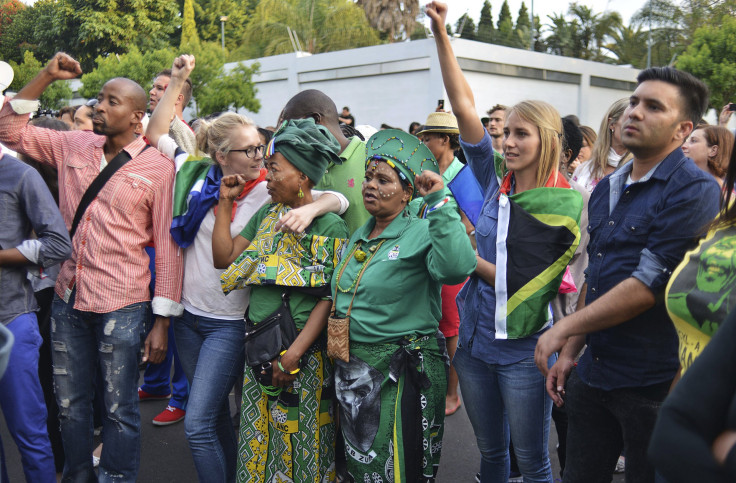Four Things Nelson ‘Madiba’ Mandela Did That Helped Revive The South Africa Economy, Which Had Been Battered by Apartheid Sanctions

South African anti-apartheid hero Nelson Mandela, who passed away Thursday at 95, is being hailed as the man who kept South Africa from ripping itself apart by advocating reconciliation instead of revenge. But often overlooked is what Mandela did specifically to turn his fractured country of 11 “homelands,” struggling under economically crippling sanctions backed by the U.S., the U.K. and 23 other countries, into Africa’s largest economy.
To be certain, the county is not fixed. Not even close. Economic disparity has worsened in recent years. Black South Africans still make significantly less than whites even as a sliver of black South Africans have prospered in the country’s free market democracy. Unemployment is soaring. Fully 10 percent of the population is HIV-positive. Labor unrest, particularly in the mining sector controlled largely by foreign interests, endures. It’s also fair to point out that under Mandela’s presidency, unemployment soared from nearly 16 percent to nearly 26 percent while average per capita incomes shrank.
But it’s hard to compare conditions in the country today to the highly volatile situation that was taking place as Mandela became the country’s first democratically elected leader in 1994. His immediate challenge was to prevent the country from ripping itself apart and becoming just another dysfunctional and politically corrupt failed African state ruled by crooks or warlords. The country’s first black and democratically elected leader had to convince white South Africans that the tables weren’t about to be turned against them to avenge decades of apartheid.
“In a political context so delicate, Mandela pointed out, you had to be very careful with the messages you put out,” wrote John Carlin, a senior writer for the Spanish daily El Pais in The Cairo Review of Global Affairs.
This is part of the reason why Mandela made F.W. de Klerk, the last apartheid-era president who was instrumental in ending South Africa’s racist policies and Mandela’s 28 years of incarceration, a deputy president.
While trying to keep the country from falling into chaos, Mandela also had to simultaneously usher in a new economic era. Certainly, the lifting of economic sanctions by foreign powers played a big external role in a new influx of capital and industrial activity, but Mandela was at the helm of a very delicate transition that less capable leaders would have easily botched or exploited for personal gain like so many charismatic leaders of struggling countries have done.
As the world pays homage to a civil rights giant, it’s worth noting that Mandela oversaw a period of profound economic transition where failure would have destroyed the country. South Africa still faces big problems, but it is still a nation under one flag.
Here are four things you should know about Mandela’s contribution to the country’s economy:
#1.) Mandela cleaned up the country’s monetary policy. Part of the new political paradigm included increasing administrative transparency at many levels. The modernization efforts Mandela oversaw at the South African Reserve Bank helped slash inflation from nearly 9.83 percent the year Mandela took office to 2.24 percent when he retired from office in 1999.
"Under the leadership of Mr. Mandela, South Africa made great strides in improving the overall quality of its institutions, which in turn has had a positive impact on the economy," wrote Shilan Shah, Africa analyst for Captial Economics, in a research note published Friday.
#2.) Mandela did not follow Robert Mugabe’s lead. Zimbabwe went through a similar, complicated transition from minority to majority rule, and many in South Africa advocated following the pattern of land appropriation from white Zimbabweans under Mugabe. Starting just a couple of years before Mandela was elected, President Mugabe began land reforms that took white Zimbabwean farmers’ properties and granted them to political cronies. Mandela faced pressure to follow a similar plan in South Africa. Fortunately, he resisted. Mugabe’s land reform policy destroyed a huge segment of national agricultural productivity, scared away regional and international investment, and sent inflation into four digits.
#3.) Mandela formed an alliance with trade unions that increased worker productivity and lowered unemployment. He oversaw a new relationship between the African National Congress, which he headed in the years before he became president, and the Congress for South African Trade Unions (COSATU). Remember, black South African suffered profound workplace discrimination under the racist policies of apartheid. Mandela worked with the unions to help boost employment opportunities for a segment of the population that needed to have more job opportunities in the new post-apartheid era. While this alliance between the ANC and COSATU is viewed by many as an impediment to jobs growth today, in the early '90s it was absolutely necessary to avoid social unrest linked to economic marginalization of low-wage black South African workers.
#4.) Mandela expressed ideological flexibility by eschewing hard-left economic theory and moving to the center. After Mandela was released from prison in 1990, his economic views were more closely aligned with those in Cuba and Venezuela today: heavy control of commercial activity by the state and complete state control over key industries. By 1994, Mandela was a Keynesian, rolling out the welcome mat to foreign investment while tightly directing industrial activity. Had Mandela held out on his earlier, more radical views, investment would have gone elsewhere. Mandela’s relaxing of his earlier stance on economics helped bring investment back to the country that had fled (or was forced to flee) during apartheid.
© Copyright IBTimes 2024. All rights reserved.





















